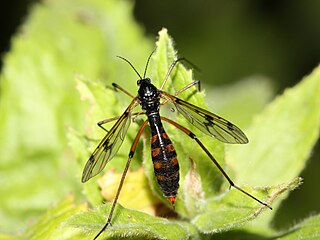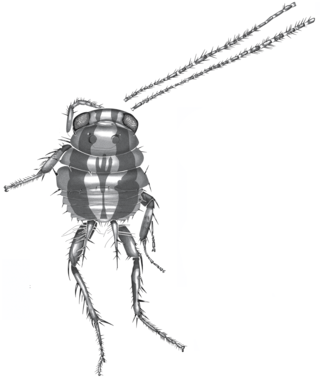
Weevils are beetles belonging to the superfamily Curculionoidea, known for their elongated snouts. They are usually small – less than 6 mm in length – and herbivorous. Approximately 97,000 species of weevils are known. They belong to several families, with most of them in the family Curculionidae. It also includes bark beetles, which while morphologically dissimilar to other weevils in lacking the distinctive snout, is a subfamily of Curculionidae. Some other beetles, although not closely related, bear the name "weevil", such as the biscuit weevil, which belongs to the family Ptinidae.

The Cupedidae are a small family of beetles, notable for the square pattern of "windows" on their elytra, which give the family their common name of reticulated beetles.

Belidae is a family of weevils, called belids or primitive weevils because they have straight antennae, unlike the "true weevils" or Curculionidae which have geniculate (elbowed) antennae. They are sometimes known as "cycad weevils", but this properly refers to a few species from the genera Parallocorynus and Rhopalotria.

The Cerophytidae are a family of beetles belonging to Elateroidea. Larvae are associated with rotting wood, on which they are presumed to feed. The family contains over 20 species in five genera, primarily distributed in the New World, but also in Eurasia and Africa. 17 fossil species in 7 genera are known extending to the Early Jurassic. Like some other elateroids, the adults are capable of clicking.

The Ptychopteridae, phantom crane flies, are a small family of nematocerous Diptera. Superficially similar in appearance to other "tipuloid" families, they lack the ocelli of the Trichoceridae, the five-branched radial vein of the Tanyderidae, and the two anal veins that reach the wing margins of the Tipulidae. They are usually allied with the Tanyderidae based on similarities of the mesonotal suture, this group being called the Ptychopteromorpha.

Anaxyelidae is a family of incense cedar wood wasps in the order Hymenoptera. It contains only one living genus, Syntexis, which has only a single species, native to Western North America. Fossils of the family extend back to the Middle Jurassic, belonging to over a dozen extinct genera, with a particularly high diversity during the Early Cretaceous. Syntexis lay eggs in the sapwood of conifers, preferring recently burnt wood.

The Berothidae are a family of winged insects of the order Neuroptera. They are known commonly as the beaded lacewings. The family was first named by Anton Handlirsch in 1906. The family consists of 24 genera and 110 living species distributed discontinuously worldwide, mostly in tropical and subtropical regions. Numerous extinct species have also been described. Their ecology is poorly known, but in the species where larval stages have been documented, the larvae are predators of termites.
Eobelinae are an extinct weevil subfamily that throve in the late Mesozoic. They belong to the family Nemonychidae. The Eobelidae were widespread, occurring at least in Central Asia, Spain and Brazil during the Late Jurassic and Early Cretaceous.

Coptoclavidae is an extinct family of aquatic beetles in the suborder Adephaga. The Coptoclavidae lived from the Late Triassic to the Early Cretaceous. Coptoclavidae is a member of the adephagan clade Dytiscoidea, which contains other aquatic beetles. Suggested reasons for their extinction to include the rise of teleost fish, or competition with Gyrinidae and Dytiscidae, which possess defensive secretions and sucking channels in the mandibles of larvae, which coptoclavids likely lacked. It has been suggested that the genus Timarchopsis and the subfamily Timarchopsinae are only distantly related to other coptoclavids based on cladistic analysis, with Timarchopsis being more closely related to geadephagans like carabids and trachypachids instead. Another study also suggested similarly for Coptoclavisca and possibly other coptoclaviscines.
Protorabinae is an extinct subfamily of beetles in the family Carabidae. It contains 36 species in 13 genera, all extinct.

Cionocoleus is an extinct genus of beetles in the family Ommatidae.
Archaeorrhynchus is an extinct genus of weevil from the family Nemonychidae. It is known from the Callovian-Oxfordian Karabastau Formation in Kazakhstan. The type species, Archaeorrhynchus tenuicornis, was named in 1926. Two other species, A. tenuicornis and A. carpenteri, were described from the same locality.

Blattulidae is an extinct family of cockroaches known from the Triassic to the Late Cretaceous. Their distinguishing characteristics include "forewing has long Sc, regular venation with distinct intercalaries and hindwing has simple CuP, branched A1."
Mesoblattinidae is an extinct family of cockroaches known from the Mesozoic. It was formerly considered a wastebasket taxon for Mesozoic cockroaches, but the family has subsequently been better defined, with many taxa transferred to Caloblattinidae. It is considered to have close affinities with Blattidae and Ectobiidae, as well as possibly Blaberidae. The family first appeared by the Early Jurassic. They are considered to represent amongst the oldest groups of modern cockroaches, and like them are thought to have laid oothecae.
Liberiblattinidae is an extinct family of cockroaches known from the Jurassic to Cretaceous. Some taxa, like Cryptoblatta and Hydrokhoohydra, are suggested to be semiaquatic. Spongistoma is suggested to be a nectarivore due to its unique sucking/sponging "proboscis" mouthparts. Some authors have suggested that the family is ancestral to Mantodea.
Rhagionemestriidae is an extinct family of brachyceran flies known from the Jurassic and Cretaceous periods. It was first named as a subfamily of the Nemestrinidae by Ussatchov (1968), and was raised to full family status by Nagatomi and Yang (1998). They are considered to be closely related to the family Acroceridae. Similar to Acroceridae, members of the family possess a large hemispherical head, with eyes covering nearly all of the area.

Archisargidae is an extinct family of brachyceran flies known from the Jurassic and Cretaceous periods. It is part of the extinct superfamily Archisargoidea. Most members of the family are known from the Callovian-Oxfordian Daohugou biota of Inner Mongolia, China, and the equivalently aged Karabastau Formation of Kazakhstan. The family has been found to be paraphyletic with respect to Eremochaetidae in a cladistic analysis.
Praeaulacidae is an extinct family of Mesozoic parasitic wasps in the suborder Evanioidea. It among the earliest known families of the group and is characterised by more complete wing venation in comparison to other members of the suborder. It has been found that Othniodellithidae is nested within Praeaulacidae via cladistic analysis.
Mesochrysopidae is an extinct family of lacewings known from the Jurassic and Cretaceous periods. They are considered to be closely related to green lacewings of the family Chrysopidae. The family are also alternatively considered a paraphyletic grade leading up to crown Chrysopidae.

Orthophlebiidae is an extinct family of scorpionflies known from the Triassic to Cretaceous, belonging to the superfamily Panorpoidea. The family is poorly defined and is probably paraphyletic, representing many primitive members of Panorpoidea with most species only known from isolated wings, and has such been considered a wastebasket taxon.












